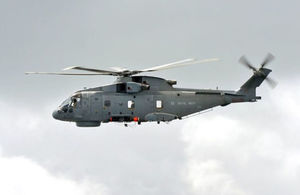Niteworks 3: Improving performance whilst reducing costs
Improving the performance and reducing the costs of the Merlin Mark 4 simulator by introducing 4 Degrees of Freedom in place of the traditional 6 Degrees of Freedom.

MOD Crown Copyright
Project Summary
Previous assumptions had suggested that helicopter simulators must have full motion platforms (6 Degrees Of Freedom (DOF)) in order to provide effective aircrew training. In 2013, Niteworks undertook a short project on behalf of the Merlin Project Team at Defence Equipment and Support (DE&S) Abbey Wood, to understand the simulation requirements for Merlin Mark (Mk) 4 training in order to acquire an affordable helicopter simulation capability.
How did Niteworks approach the task?
Previous assumptions had suggested that helicopter simulators must have full motion platforms (6 Degrees Of Freedom (DOF)) in order to provide effective aircrew training. Niteworks conducted a short, innovative and objective assessment of the role of motion cueing in helicopter training through a mixture of qualitative and quantitative analysis. In short, the aim was to determine whether it was necessary to have a full motion platform or whether a less expensive option was feasible, without effecting the efficacy of training.
The Niteworks project team analysed evidence gathered from various sources, including a capability concept demonstrator, interviews with leading subject matter experts (in both training and operational fields), a comprehensive review of published work and regulatory requirements, benchmarking against other simulators in use within the UK and overseas, and engagement with academia (in particular, Liverpool University). Various stakeholders were engaged at a senior level during the process, including DE&S, Joint Helicopter Command, Navy HQ, HQ Air Command and the Military Aviation Authority.
What was the outcome?
The majority of quantitative evidence suggested that whilst the presence of motion did improve crew performance in the simulator, it had no effect on the transfer of that training to the real helicopter. Results of the qualitative analysis concluded that motion cues are most important as the first indicator of manoeuvre, with subsequent motion cues becoming less significant.
A review of all the evidence led to the overall recommendation that alternative simulator training equipment such as modern motion seats could provide the required training performance whilst reducing costs. Niteworks was particularly well placed to carry out this project due to its ability to access the most credible pan-industry and academic expertise in a timely manner for both leading and informing the project. In addition, the success of the project also relied on the Niteworks project team’s ability to identify and engage with all the relevant stakeholders within Ministry of Defence (MOD) at the right level.
The project’s achievements were recognised by BAE Systems, one of 12 major industry partners in Niteworks, through the award of a commendation under its annual Chairman’s Award Scheme.
Where are we now?
The MOD exploited this Niteworks output through a change in Joint Helicopter Command policy and more directly for the acquisition of new Merlin simulators to conduct Conversion to Role training at Royal Naval Air Station Yeovilton. These devices will employ motion seats in lieu of full 6 DOF motion with associated cost savings. The revised approach has also had positive implications on building capacity and costs. The use of fixed-based platforms with on-set motion cued seats not only saves on simulator purchase, it saves on building construction through its smaller footprint/height and through life costs.
What were the benefits?
- a fit-for- purpose training system for Merlin Mk 4 can be delivered within tight financial constraints
- immediate and consequent through life savings from this short, comprehensive study represent an order of magnitude reduction in cost to the MOD over previous training solutions